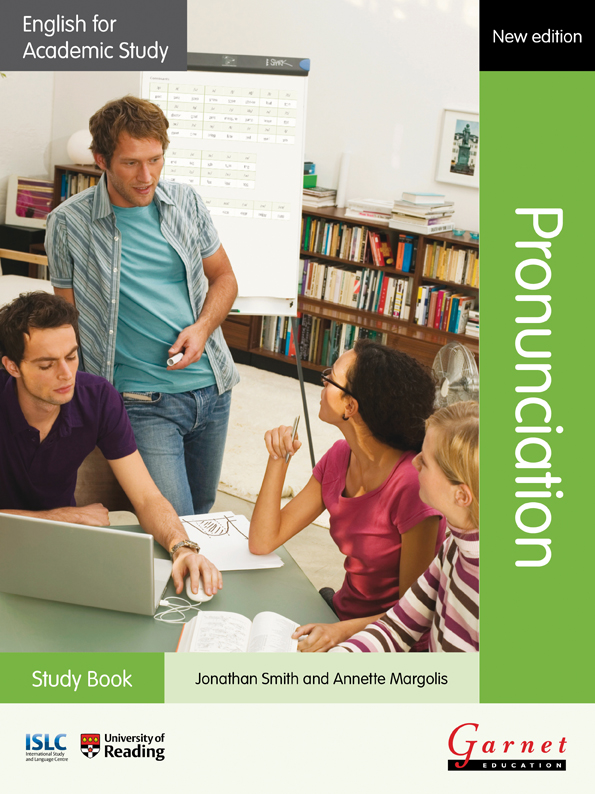About the book
English for Academic Study: Pronunciation
This fully updated 2012 edition of English for Academic Study: Pronunciation will help you develop the pronunciation skills you need to communicate clearly and effectively in an academic environment.
The units are based on the following topics:
- Vowel sounds 1, word stress and weak forms
- Vowel sounds 2, word stress patterns
- Consonant sounds 1, sentence stress
- Consonant sounds 2, word stress on two-syllable words
- Diphthongs 1, sounds in connected speech
- Consonant clusters 1, tone units 1
- Diphthongs 2, tone units 2
- Consonant clusters 2, intonation
Each unit explores a key aspect of English pronunciation, for example, the pronunciation of individual sounds, syllables and word stress patterns. The written and listening texts, which focus on key academic vocabulary, will allow you to practise your pronunciation so that you can be understood with ease.
EAS: Pronunciation includes unit summaries to give you a quick overview of what you have covered, and a comprehensive glossary of terms. Each unit also has weblinks offering additional information and activities, relating to both pronunciation skills and the topics covered in the units.
This book can be used in conjunction with the following books in the English for Academic Study (EAS) series, also published by Garnet Education: EAS: Reading, EAS: Writing, EAS: Extended Writing & Research Skills, EAS: Speaking, EAS: Vocabulary, EAS: Listening and EAS: Grammar for Writing.
Contents
i. Introduction
p. Phonemic alphabet
1. Vowel sounds 1, word stress and weak forms
2. Vowel sounds 2, word stress patterns
3. Consonant sounds 1, sentence stress
4. Consonant sounds 2, word stress on two-syllable words
5. Diphthongs 1, sounds in connected speech
6. Consonant clusters 1, tone units 1
7. Diphthongs 2, tone units 2
8. Consonant clusters 2, intonation
g. Glossary
t. Transcripts
a. Answer key
Author details
Annette Margolis is a teacher at an Italian Commercial High School and an assistant Cambridge ESOL Young Learner CELTA Extension Tutor.
Annette has co-presented for Garnet Education with Jonathan Smith at IATEFL (2008) and set up a wikispace for her EAP pre-sessional students at the University of Birmingham.
She has co-authored the Pronunciation volume in the English for Academic Study series.
Jonathan Smith has many years’ experience teaching and teacher training in Europe, North Africa and the Far East, and now works as an EAP lecturer and course director at the Centre for Applied Language Studies at the University of Reading.
His academic interests include the teaching of oral skills and the applications of technology in language learning. He has co-authored two books in the English for Academic Study series: Listening and Pronunciation.
Reviews
"This self-study course, which enables students to approach listening via pronunciation, is a valuable aid to differentiation in EAP classes. It has proved very popular!"
Amanda Smith, INTO Manchester
"It is the only coursebook currently published that attempts to deal with this important area of English. Garnet Education are to be congratulated, then, for taking on the challenge of pronunciation for EAP (and for stealing a march on the other publishers)."
Robin Walker for Speak Out! (newsletter of the IATEFL Pronunciation SIG), February 2013
“The EAS Pronunciation Study Book is well-structured, introducing the phonetic alphabet and teaching students how to pronounce all the 44 phonemic symbols of Received Pronunciation (RP). Students can then read the phonemic transcription of words in the dictionary and pronounce new words correctly. Each chapter focuses on different problem areas, such as vowels (useful to French and Italian speakers), word stress, consonants, consonant clusters, and voiced/unvoiced consonants (useful to Swiss-German speakers). Diagrams are provided showing the position of the tongue in relation to the teeth, lips, and roof of the mouth for consonants.
I would recommend this course to individual students needing to improve their pronunciation. My only reservation about it is that it is not stated clearly that the course is teaching RP. Many of us would have to change our accents in order to model all the vowels and diphthongs as they are transcribed. Fortunately, there is no need for this, as the self-study book and two CDs allow students to work on it alone.”
Margaret Oertig for ETAS Journal, Vol. 30, No 3, Summer 2013




